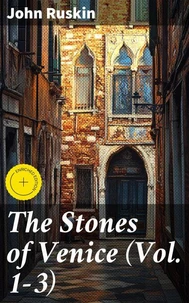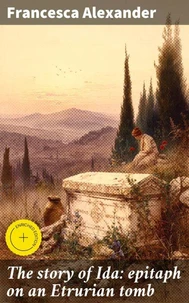Giotto and his works in Padua. An Explanatory Notice of the Series of Woodcuts Executed for the Arundel Society After the Frescoes in the Arena Chapel
Par :Formats :
Disponible dans votre compte client Decitre ou Furet du Nord dès validation de votre commande. Le format ePub est :
- Compatible avec une lecture sur My Vivlio (smartphone, tablette, ordinateur)
- Compatible avec une lecture sur liseuses Vivlio
- Pour les liseuses autres que Vivlio, vous devez utiliser le logiciel Adobe Digital Edition. Non compatible avec la lecture sur les liseuses Kindle, Remarkable et Sony
 , qui est-ce ?
, qui est-ce ?Notre partenaire de plateforme de lecture numérique où vous retrouverez l'ensemble de vos ebooks gratuitement
Pour en savoir plus sur nos ebooks, consultez notre aide en ligne ici
- Nombre de pages67
- FormatePub
- ISBN859-65--4721218-8
- EAN8596547212188
- Date de parution04/09/2022
- Protection num.Digital Watermarking
- Taille510 Ko
- Infos supplémentairesepub
- ÉditeurDIGICAT
Résumé
In "Giotto and his Works in Padua, " John Ruskin embarks on an intricate exploration of the artistic legacy of Giotto di Bondone, situating the painter within the larger tapestry of Italy's Gothic and Renaissance transitions. Written in a rich, sartorial prose reminiscent of the Romantic era, the book offers detailed perceptions of Giotto's frescoes in the Scrovegni Chapel. Ruskin meticulously analyzes themes of divine intervention and human emotion, while employing a keen observational style that intermingles art criticism with a deep philosophical inquiry into beauty, morality, and spirituality, thereby providing a rejuvenating context to the artist's work during the early 14th century.
John Ruskin, a prominent Victorian critic and social thinker, devoted his intellectual and artistic endeavors to championing the Gothic revival and critiquing industrial society. Influenced by his own affinity for nature and beauty, as well as contemporaneous socio-economic turmoil, Ruskin's passion for art and architecture is palpably evident in this text. His travels throughout Italy, during which he immersed himself in the works of the old masters, galvanized his understanding of how art and society intertwine, leading to this profound tribute to Giotto.
"Giotto and his Works in Padua" is essential for both art historians and enthusiasts alike, offering a compelling lens through which to appreciate Giotto's pivotal role in art history. Ruskin's insights not only enhance our understanding of the aesthetics of the period but also inspire a broader dialogue about the enduring significance of artistry in our lives today. With this book, readers are invited to observe the intersections of art, humanity, and spirituality in a richly illuminating manner.
John Ruskin, a prominent Victorian critic and social thinker, devoted his intellectual and artistic endeavors to championing the Gothic revival and critiquing industrial society. Influenced by his own affinity for nature and beauty, as well as contemporaneous socio-economic turmoil, Ruskin's passion for art and architecture is palpably evident in this text. His travels throughout Italy, during which he immersed himself in the works of the old masters, galvanized his understanding of how art and society intertwine, leading to this profound tribute to Giotto.
"Giotto and his Works in Padua" is essential for both art historians and enthusiasts alike, offering a compelling lens through which to appreciate Giotto's pivotal role in art history. Ruskin's insights not only enhance our understanding of the aesthetics of the period but also inspire a broader dialogue about the enduring significance of artistry in our lives today. With this book, readers are invited to observe the intersections of art, humanity, and spirituality in a richly illuminating manner.
In "Giotto and his Works in Padua, " John Ruskin embarks on an intricate exploration of the artistic legacy of Giotto di Bondone, situating the painter within the larger tapestry of Italy's Gothic and Renaissance transitions. Written in a rich, sartorial prose reminiscent of the Romantic era, the book offers detailed perceptions of Giotto's frescoes in the Scrovegni Chapel. Ruskin meticulously analyzes themes of divine intervention and human emotion, while employing a keen observational style that intermingles art criticism with a deep philosophical inquiry into beauty, morality, and spirituality, thereby providing a rejuvenating context to the artist's work during the early 14th century.
John Ruskin, a prominent Victorian critic and social thinker, devoted his intellectual and artistic endeavors to championing the Gothic revival and critiquing industrial society. Influenced by his own affinity for nature and beauty, as well as contemporaneous socio-economic turmoil, Ruskin's passion for art and architecture is palpably evident in this text. His travels throughout Italy, during which he immersed himself in the works of the old masters, galvanized his understanding of how art and society intertwine, leading to this profound tribute to Giotto.
"Giotto and his Works in Padua" is essential for both art historians and enthusiasts alike, offering a compelling lens through which to appreciate Giotto's pivotal role in art history. Ruskin's insights not only enhance our understanding of the aesthetics of the period but also inspire a broader dialogue about the enduring significance of artistry in our lives today. With this book, readers are invited to observe the intersections of art, humanity, and spirituality in a richly illuminating manner.
John Ruskin, a prominent Victorian critic and social thinker, devoted his intellectual and artistic endeavors to championing the Gothic revival and critiquing industrial society. Influenced by his own affinity for nature and beauty, as well as contemporaneous socio-economic turmoil, Ruskin's passion for art and architecture is palpably evident in this text. His travels throughout Italy, during which he immersed himself in the works of the old masters, galvanized his understanding of how art and society intertwine, leading to this profound tribute to Giotto.
"Giotto and his Works in Padua" is essential for both art historians and enthusiasts alike, offering a compelling lens through which to appreciate Giotto's pivotal role in art history. Ruskin's insights not only enhance our understanding of the aesthetics of the period but also inspire a broader dialogue about the enduring significance of artistry in our lives today. With this book, readers are invited to observe the intersections of art, humanity, and spirituality in a richly illuminating manner.




